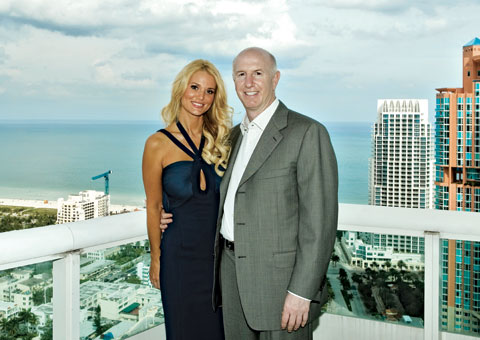Marc Roberts Rules

[highlight_text] “We’re developing a new city—20 million square feet and more than four-and-a-half years of planning, but the first phase will be a lot of retail. [/highlight_text]
These are the rules. Repeat after me: Go for it! Sell with pizzazz. Put a spin on trouble. Network smart. Match the person to the job. Get them psyched! Nurture loyalty. Pay attention. Advertise. Pitch with conviction. Follow success. Keep your eyes open. Know how to negotiate. Work a room. Party hard. Keep your enemies close. Stand out from the crowd. Be reliable. Trust your gut. Give back.
Those are the rules. And somewhere, right now, Marc Roberts is following at least one of them, or, most likely, all of them, because they’re his rules. He’s out there, conceptualizing, schmoozing, networking, befriending, strategizing, and you should be afraid for your entrepreneurial life, because he’ll out-dream you, he’ll out-passion you, and he’ll outwork you. Because he’s nonstop. Because he’ll risk his neck. Because he’s loyal. Because he’s a beast. Because he always has been. Because he always will be. And because he’s having fun the whole way through.
That’s how his sports management company, Worldwide Entertainment and Sports, was the first to public through an IPO. That’s how he became a real estate magnate. And that’s how he’ll transform downtown Miami into a world-class destination by developing the Miami Worldcenter.
And, as I write this, I realize that wherever he is, he’s probably got March Madness. Tennessee is playing the heavy underdog American University in the NCAA men’s basketball tournament, which is no small coincidence—trace the roots of Marc Roberts’ gumption and you’ll find American University’s hoops squarely at the source. As a late ’70s high school star from New Jersey, Roberts was a sharp shooting guard and heavily recruited by Division II (read: small schools), yet was seen as too short and scrawny to play Division I. Roberts first contacted the American coach, Jim Lynam, who resigned and was replaced by Gary Williams, and made a simple deal: “If I walk on and make the team then you give me a scholarship.” He hit the American hardwood and shot lights out. The plan worked.
About midway through the season, sports agents were slithering all over campus. They were after the team’s stud baller, Russell “Boo” Bowers, who was the leading scorer in the country. Everywhere Bowers went, agents swarmed. His concentration was compromised, as was his play. When the coach realized what was happening, he put out an edict: any agent on campus gets arrested. And as soon as one did, the agents quickly vanished. Roberts realized an invaluable opportunity was staring him in the face. “I practice with the guy. I travel with the guy. I live in the dorm room next to his. I want to be his agent. So I’d better become his best friend. I used my networking skills, and lo and behold I became his agent. He was my first client.” Bowers was set to be a top 10 draft pick before tearing a ligament in the final game of his college career. He ultimately was drafted 59th overall by the Cleveland Cavaliers in the 1981 draft.
Flush with that success at age 19, Roberts quit college, was summarily thrown out of his parents’ house, and began learning all he could about promoting professional athletes. “I signed John ‘Up the Ladder’ Williamson, an NBA star whose number the New Jersey Nets retired. And then I signed a few minor league baseball guys, and there was a big article in the paper, my local paper,” Roberts recalls. A sergeant in the Irvington police department read the piece and contacted Roberts to represent some fighters, which Roberts agreed to do.
That soon turned into a career-making love affair with boxing, which further solidified his career. He became the youngest promoter in the boxing realm when he was still only 19. Living in an attic apartment in Summit, New Jersey, barely scraping by, he hung around a gym in Plainfield, learning the ropes and signing a few fighters here and there. Roberts soon realized he was in over his head. He sought money-raising advice from his friends Roy Greenman and Arnie Budin, who suggested a limited partnership, wherein people would each invest $2,500. Through brazen relentlessness, Roberts raised $25,000. “I started asking my friends’ parents, and basically anyone in the world, if they had $2,500. I felt like the moll,” he laughs. Then Tommy “The Hit Man” Hearns came to town with his legendary trainer, Emanuel Steward, to do an exhibition with Muhammad Ali. “I went up to Steward and told him, ‘I’m an expert at endorsements. I control Madison Avenue.’ Meanwhile, I never did an endorsement deal in my whole life.” But Emanuel bought into it, and Roberts wound up with an exclusive with Hearns.
With a superstar like Hearns in tow, Roberts quickly pounced on another revenue stream: the closed circuit fight. Roberts was able to meet someone in mega-promoter Bob Arum’s entourage, and decided to parner with him. “I got a location, sold out the Hearns-Leonard fight and made a couple hundred thousand dollars,” Roberts recounts. “When I started getting territorial rights for the whole of Jersey, that’s when I started making serious money.” And although the partner would eventually stab Roberts in the back, Roberts kept his cool, along with the partnership, which allowed him to get in better with Arum.
In 1987, Arum offered Roberts the mother load. “Bob said, ‘OK, kid you’re ready, let’s go after the U.S. Olympic boxers together. I’ll be the promoter; you’ll manage it,’” Roberts says. After that success, in 1988, Roberts formed the Triple Threat Enterprises boxing team by signing three of the Olympians: heavyweight gold medalist Ray “Merciless” Mercer, junior welterweight Charles “The Natural” Murray, and light heavyweight Al “Ice” Cole. “It was historic,” Roberts crows. “No one had taken three names and marketed them into a brand before.” This led Roberts to his next “light bulb moment.” “I didn’t know anything about buying stock, but I knew companies would take themselves public and sell themselves to a massive amount of people,” Roberts says. Based on the popularity of his fights, Roberts knew he was onto something.
Despite being called crazy, Roberts embarked on taking the boxers public, and through typical Roberts brashness and perseverance, it finally came to fruition. In 1990, Roberts became the first and only person to take a boxing management company public. “We first raised $5 million, and eventually we raised more than $150 million for three fighters and riverboat gaming through additional offerings.” The stock debuted at $5 a unit, but skyrocketed to $164. In 1991, Roberts managed Ray Mercer as he became heavyweight champion of the world. “After he won, we had the party of parties,” Roberts laughs.
After leaving Triple Threat, Roberts founded Worldwide Entertainment and Sports in 1995. Expanding his reach, Roberts represented not only big-name boxers like Shannon Briggs, but also NFL, NBA, and NASCAR athletes. His stable went from five pros to more than 100, and in 1996 he became the first person to take a diversified sports management company public. But by 2000, he knew it was time for a change. “I always planned my exit when I was 40. I wanted to succeed in a whole new industry.” So he sold his stake as president and chairman of Worldwide Entertainment and Sports and made a hefty sum of money. He brought his sizable Roladex south to Florida, and focused on the booming real estate market. And we’re back to Rule No. 1: Go for it.
Roberts wants to recreate Miami. “The city is missing a place where people can walk,” he says, reconfirming what we know all too well. With the help of partner Art Falcone, who sold his private company, Transeastern Homes, to a public entity in 2005 for more than $1 billion, Roberts is developing areas of downtown Miami near American Airlines Arena. “This is the best assemblage of land in any top tier city in America,” says Roberts. “We’re developing a new city—20 million square feet and more than four-and-a-half years of planning, but the first phase will be a lot of retail. If we stay the course it will be just like a modern day Rockefeller move. I look at it like buying in New York in the ’50s or ’60s.” The project, dubbed Miami Worldcenter, encompasses close to 30 acres, including parcels on Biscayne Boulevard. Roberts has the rights to build a live-work-play environment that he hopes to make the new center of Miami. “There is no better place to do this because Miami is the greatest city in the world. Everyone wants to be here.” The land that Roberts controls offers up to 20 million square feet of buildable area, making this project one of the largest, private, master-planned urban environments in the world. And while many others may have dreamt on such a large scale, Roberts is doing what he does best: making it happen. “For the first time, someone owns the critical mass to get it done,” he explains. “Now for the first time, it is all in Art Falcone and my hands, and planned the way it should be.”
In the midst of it all, Roberts finds a way to give back. “My wife, who I got very lucky with, always says the number one thing she likes is that I help so many people,” he says. Roberts was named the Crohn’s and Colitis Man of the Year for South Florida. He is also responsible for the single largest donation to Camp ASCCA in Alabama, the world’s largest barrier-free camp for adults and kids with disabilities. Roberts has also sponsored kids to go and compete in the Maccabiah Games. “We are always trying to give back and do the right thing,” Roberts says. He knows that such a philosophy is the foundation of solid, long-lasting friendships. It also helps everyone involved to keep going, no matter the obstacles. And it frames all the other rules. “A quitter never wins and a winner never quits—it’s in my high school yearbook. And I live by that.”












